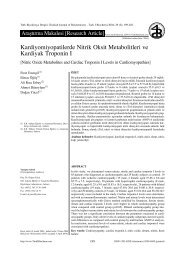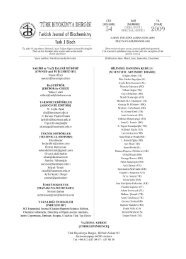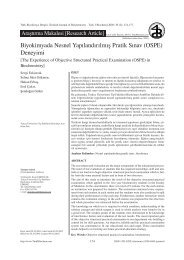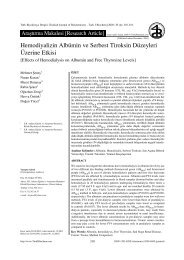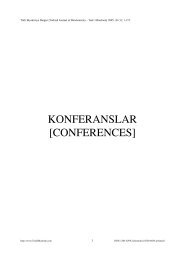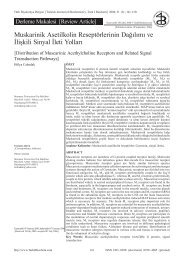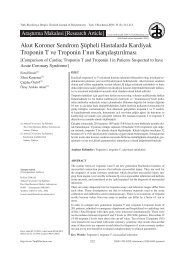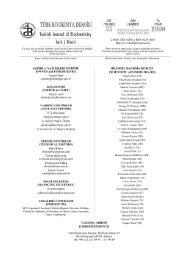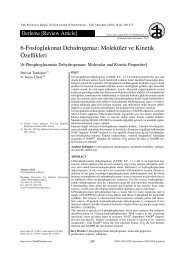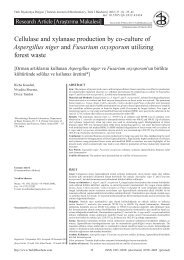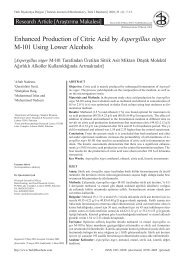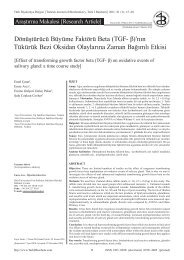24. Ulusal Biyokimya Kongresi - Türk Biyokimya Dergisi
24. Ulusal Biyokimya Kongresi - Türk Biyokimya Dergisi
24. Ulusal Biyokimya Kongresi - Türk Biyokimya Dergisi
- No tags were found...
You also want an ePaper? Increase the reach of your titles
YUMPU automatically turns print PDFs into web optimized ePapers that Google loves.
XXIV. ULUSAL B‹YOK‹MYA KONGRES‹<br />
25 - 28 Eylül 2012<br />
Dedeman Otel - Konya<br />
<strong>24.</strong> <strong>Ulusal</strong> <strong>Biyokimya</strong> <strong>Kongresi</strong>, Konya [24 th National Biochemistry Congress, Konya / TURKEY]<br />
İÇİNDEKİLER<br />
DAVETLİ KONUŞMACI ÖZETLERİ<br />
BİLİMSEL MAKALE YAZIMI – EDİTÖR OLARAK GENEL<br />
BEKLENTİLER<br />
Yahya LALELİ<br />
Yayına gönderilecek makale, bir fikri, bir düşünceyi, bir araştırma veya uygulamayı<br />
kanıta bağlı olarak sonuçlandırmalı, bu sonuçtan bir değer yaratmalıdır. Yani<br />
sonuçlandırılmış, neticelendirilmiş ve paylaşıldığında paydaşlara ilave katkı<br />
sağlayacak veya belirli şartlarda teyidi veya aksi söylenecek, genelde pozitif<br />
verilerin okuyucuyu cezbedecek şekilde sunulmasıdır.<br />
Makalenin kapsamı standart olarak kabul edilen IMRAD (introduction, method,<br />
results, discussion) – GMST (giriş, metod, sonuç, tartışma) olarak adlandırılan<br />
bölümlerden oluşmakla beraber; IRDAM (introduction, results, discussion ve<br />
gerektiğinde tekrarlanabilir şekilde detay veren metod) olarak tanımlanan formatı<br />
da mevcuttur. Makalede, etkinliğin genişletildiği giriş; sonucu destekleyecek<br />
uygulamanın güvenilir olduğunu belirtecek kadar kısıtlı, detaydan kaçan metod;<br />
girişteki hipoteze/soruya net cevap veren sonuç ve sonucu değerlendiren tartışma<br />
bölümleri bulunmalıdır. Konuşmacılarımız Türk <strong>Biyokimya</strong> <strong>Dergisi</strong> (TBD)’nde<br />
makalenin yapısal bölümlerinde neler beklediklerimiz yanında bu bölümlerde<br />
sıkça rastladığımız hataları ve etkin yazım dili önerilerini dile getireceklerdir.<br />
IMRAD formatı bir araştırmanın sunulması için standart kabul edilmekte,<br />
hatta çalışmalar da genelde bu formatta planlanmaktadır. Bir makale yazıma<br />
hazırlandığında sonuçlar elimizde demektir. O zaman makale IMRAD veya<br />
bilhassa IRDAM formatında hazırlanırken sonuç bazlı, sonuç odaklı olmalıyız,<br />
beklenen de budur.<br />
Makalenin sonuç odaklı olması kaçınılmaz bir gereksinimdir. Bu nedenle makale<br />
yazımının sonuç üzerinden planlanması; makalenin adından başlayıp, o sonucun<br />
elde edilme gereksinimlerini, elde edebilmek için kullanılan metodolojik yaklaşımın<br />
güvencesini ve sonucun değerlendirilmesini, yorumunu, teferruata boğulmadan<br />
söylenmek istenenin etkin bir şekilde sunulmasını sağlayacaktır. Bir makalenin<br />
sonuç odaklı olarak belirli bir formatta net ama sebep sonuç ilişkisinin öz olarak<br />
sunumu, makalenin kapsamı kadar okunurluğunda da etkindir. Makalenin etkin<br />
olan bilinir bir kalıpta yazılması, makalenin adının verdiği, vereceğini belirttiği<br />
bilginin ne kadarını nerede arayacağını bilen bir okuyucunun arayışına cevap<br />
verir! Editörün de isteği katma değer yaratacak bir sonucu yukarıdaki format ve<br />
çerçeve içinde kaleme alınmış makaleler halinde yayınlamaktır.<br />
Türk <strong>Biyokimya</strong> <strong>Dergisi</strong>’ne yayın için gönderilen makale, Bölüm Editörü<br />
tarafından ön değerlendirmeye alınmaktadır. Makale kabulünden önce makalenin<br />
araştırılması bölüm editörünün, uygulanan istatistiksel yöntemlerin (denek<br />
WRITING A SCIENTIFIC ARTICLE – GENERAL EXPECTATIONS AS<br />
AN EDITOR<br />
Yahya LALELI<br />
A manuscript should compose the results of an idea, an opinion, a research or<br />
implementation based on evidences and should form an added value from these<br />
results. That is, a manuscript is the presentation of finalized, mostly positive, data<br />
which have added value to the readers and can be confirmed or disproved under<br />
defined conditions, written in a way to attract the readers’ attention.<br />
Contents of a manuscript is composed of IMRAD (acronym of introduction,<br />
method, results, and discussion), which is universally accepted as the standard.<br />
Nevertheless, there is also an IRDAM version which is composed of introduction,<br />
results, discussion and if necessary, method, detailed for reproducibility. In<br />
Introduction, efficiency of the manuscript should be extended; in Methods, it<br />
should be given by avoiding unnecessary detail that the applied methods are<br />
reliable to support the obtained results; in Results, the initial hypothesis/query<br />
should be clearly answered; and in Discussion, the obtained results should be<br />
interpreted. Speakers of this panel will present the expectation of Turkish Journal<br />
of Biochemistry with regard to the contents of a manuscript as well as common<br />
mistakes that we frequently notice and also our suggestions for effective language.<br />
IMRAD style is accepted as a standard for the presentation of a research, and<br />
most of the time researches are planned in accordance with this style. When a<br />
manuscript is started to be written, it means that the results are already obtained.<br />
Thus, if a manuscript is written in IMRAD style, or especially in IRDAM style,<br />
it should be formed with a results based, results oriented approach; and that is the<br />
expected thing to do.<br />
It’s a necessity that a manuscript is written with a results oriented approach. Hence,<br />
planning the writing of a manuscript based on the results would lead to efficient<br />
presentation without unnecessary details, including the title, the necessity to obtain<br />
those results, reliability of the methods used, and the interpretation of them. Clearly<br />
presenting the aim-result relation in a defined style affects the readability of an article as<br />
well as its content. Writing a manuscript with an effective, well-known style answers a<br />
reader who knows to found the related information s/he is interested in. In addition, it<br />
is also an editor’s request to publish manuscripts with an added value written in above<br />
mentioned style and concept.<br />
In Turkish Journal of Biochemistry, a submitted manuscript was preliminary evaluated<br />
by related Section Editor. While Section Editor is responsible for the preliminary<br />
evaluation of the content of a manuscript, its Statistics Editor’s responsibility to<br />
CONTENTS<br />
ABSTRACTS OF INVITED LECTURES<br />
Turk J Biochem, 2012; 37 (S1)<br />
http://www.TurkJBiochem.com



